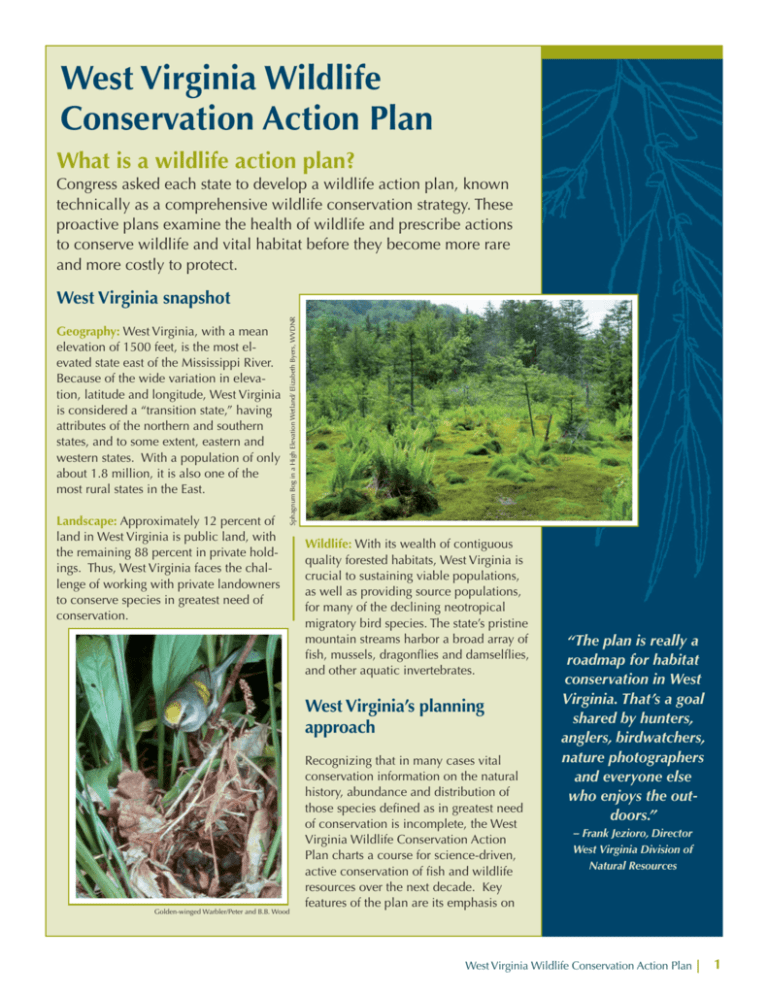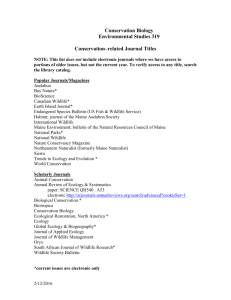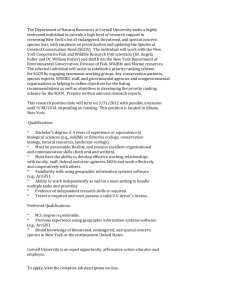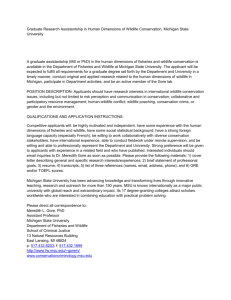Summary of West Virginia Wildlife Action Plan
advertisement

Subhead 1 West Virginia Wildlife Conservation Action Plan Subhead 1 Main body copy. Main body copy. Main Main body copy. Main body copy. Main copy.Main body copy. Main body copy. copy.Main body copy. Main body copy. Main body copy.Main body copy. Main Main body copy.Main body copy. Main body copy.Main body copy. Main body body copy.Main body copy. Main body copy.Main body copy. Main body copy. copy.Main body copy. Main body copy. Main body copy. Main body copy.Main Main body copy. Main body copy.Main Congress asked each a wildlife action body copy.Main body copy.state to developbody copy.Main body plan, copy. known What is a wildlife action plan? body copy.Main body copy. Main body West Virginia snapshot copy.Main body copy. Main body copy. Main body copy. Main body copy.Main Geography: Westbody Virginia, a mean body copy.Main copy.with Main body elevation of 1500 feet, is the most elcopy. Main body copy. Main body copy. evated state east of the Mississippi River. Main body copy. Main body copy.Main Because of the wide variation in elevabody copy. Main body copy.Main body tion, latitude and longitude, West Virginia copy.Main body copy. Main body copy. is considered a “transition state,” having Main body copy. Main body copy.Main attributes of the northern and southern body copy. Main body copy.Main body states, and to some extent, eastern and copy. Main body copy.Main body copy. western states. With a population of only Main copy. it is also one of the about body 1.8 million, most rural states in the East. Main body copy. Main body copy. Main body copy. Main body copy.12Main body Landscape: Approximately percent of copy.Main body copy.isMain body copy. land in West Virginia public land, with Main body copy.Main body the remaining 88 percent in copy. privateMain holdbody copy.Main body copy. Main body ings. Thus, West Virginia faces the chalcopy.Main body copy. Main body copy. lenge of working with private landowners Main body copy. Main body copy.Main to conserve species in greatest need of body copy. Main body copy. conservation. Sphagnum Bog in a High Elevation Wetland/ Elizabeth Byers, WVDNR technically as a comprehensive wildlife conservation strategy. These Main body copy. Main body copy. body copy. Main body copy. Main proactive plans examine theMain health ofMain wildlife and prescribe actions body copy. Main body copy. Main body body copy. Main body copy. Main body to conserve wildlife and vital habitat before they become more rare copy.Main body copy. Main body copy. copy.Main body copy. Main body copy. and more costly to protect. Main body copy.Main body copy. Main Main body copy.Main body copy. Main Subhead 2 Main body copy. Main body copy. Main body copy. Main body copy. Main body copy. Main body copy.Main body copy.Main body copy. Main body copy.Main body copy. Main body copy. Main body copy. Main body copy.Main body copy. Main body copy. Main body copy.Main body copy. Main body copy. Main body copy. Main body copy. Main body copy. Main body copy.Main body copy. Main body copy.Main body copy. Main body copy. Main body copy.Main body copy. Main body copy.Main body copy. Main body copy. Main body copy. Main body copy.Main body copy.Main body copy. Main body copy. Main body copy. Main body copy. Golden-winged Warbler/Peter and B.B. Wood body copy.Main body copy. Main body copy.Main body copy. Main body copy. Main body copy. Main body copy.Main body copy.Main body copy. Main body copy. Main body copy. Main body copy. Main body copy. Main body copy.Main body copy. Main body copy.Main body copy.Main body copy. Main body copy. Main body copy. Main body copy.Main body copy. Main body copy.Main body copy. Main body copy. Main body copy. Main body copy. Main body copy. Main body copy. Main body copy. Main body copy. Main body copy.Main body copy. Main body copy. Wildlife: With its wealth of contiguous Main body copy.Main body copy. Main quality forested habitats, West Virginia body copy.Main body copy. Main bodyis crucial to sustaining viable populations, copy.Main body copy. Main body copy. as well as providing source populations, Main body copy. Main body copy.Main for many of the declining neotropical body copy. Main body copy. migratory bird species. The state’s pristine mountain streams harbor a broad array of Subhead 2 Main body copy. Main body fish, mussels, dragonflies and damselflies, copy. Main body copy. Main body copy. and other aquatic invertebrates. Main body copy. Main body copy.Main body copy.Main body copy. Main body West Virginia’s copy.Main body copy.planning Main body copy. Main body copy. Main body copy.Main approach body copy. Main body copy. Main body Recognizing thatcopy. in many cases vital copy.Main body Main body copy. conservation information on copy. the natural Main body copy. Main body Main history, abundance and distribution of body copy. Main body copy.Main body those species defi ned as in greatest need copy. Main body copy.Main body copy. of conservation incomplete, the West Main body copy.isMain body copy.Main Virginia Wildlife Action body copy. Main Conservation body copy.Main body Plan charts a course for science-driven, copy. Main body copy. Main body copy. active conservation of fi sh and wildlife Main body copy.Main body copy.Main resources over the next decade. Key body copy. Main body copy. Main body features of the plan are its emphasis on copy. Main body copy. “The plan is really a roadmap for habitat conservation in West Virginia. That’s a goal shared by hunters, anglers, birdwatchers, nature photographers and everyone else who enjoys the outdoors.” – Frank Jezioro, Director West Virginia Division of Natural Resources West Virginia Wildlife Conservation Action Plan 1 conservation actions, including a habitat conservation initiative, and the collaborative approach to plan implementation. The plan is both species- and habitatbased, its core component being the 128 species and species group fact sheets that will function as miniplans within the broader comprehensive plan. Although the plan covers a ten-year span, it is actually only the first step in a continuous, adaptive management process for collaborative conservaAllegheny Woodrat tion of the state’s fish and /Jeff Hajenga, WVDNR wildlife resources and the habitats that sustain them. Wildlife Birds Total number of species Primary challenges to conserving wildlife in West Virginia The West Virginia Wildlife Conservation Action Plan identifies eight major conservation issues, although 12 others were identified in the planning process and identified in the individual fact sheets. The three major regional conservation issues include mining, commercial and residential development and atmospheric acid deposition. The remaining five major conservation issues occur statewide and include stream sedimentation, forest health, invasive species, water pollution and in-stream, wetland and riparian habitat loss. Species of Threatened/ conservation concern* endangered** 234 74 1 Mammals 72 26 3 Amphibians 49 19 1 Reptiles 39 20 0 180 73 0 Mussels 69 43 6 Crayfish 21 9 0 Snails (land) 130 10 1 Cave invertebrates 190 87 1 Butterflies 128 31 0 Tiger beetles 12 12 0 Stoneflies*** 12 12 0 Odonates**** 146 72 0 92 17 0 401 18 0 524 13 Fish Moths***** Spiders****** Totals *Each state is using its own criteria for this category. The West Virginia focus is on species that exhibit a lack of specific or quantifiable data, small or declining populations, are found in habitats facing imminent threats, or on the federal threatened and endangered species list. **West Virginia has no state designated threatened or endangered species. Species listed in this column appear on the Federal Threatened and Endangered Species List. *** Species listed here are those that appear only on the West Virginia Natural Heritage List of Tracked Species. It is estimated that there are 135 species in the state. ****Odonates are dragonflies and damselflies. *****The species listed here represent only those species in the WVDNR database. ******The species listed here represent only vouchered specimens; it is estimated that there are about 650 species in the state Wildlife highlights 2 West Virginia Wildlife Conservation Action Plan Highlight habitats Wildlife (examples) Issue (examples) Action (examples) Red Spruce Northern Flying Squirrel, Cheat Mountain Salamander • Spruce conversion, loss to development and forest fragmentation • Work with the Monongahela National Forest to develop and carry out a red spruce management plan Several rare bat species, many globally rare cave invertebrates • Loss to development and sedimentation • Cave gates Mix of public/ private ownership Caves Mix of public/ private ownership • Conserve additional habitat through easement purchases or donations • Monitoring • Easements • Management of surface areas for recharge of cave streams Streams Mix of public/ private riparian ownership Candy Darter, Crystal Darter, Elk River Crayfish • Mine drainage, atmospheric acid deposition, sedimentation, and losses of riparian buffers • Stream liming • Catalogue potential habitat conservation projects for implementation with a variety of partnerships Working together for West Virginia’s wildlife Over a period of two years the West Virginia Division of Natural Resources held several meetings with 31 experts to review the lists of candidate species in order to select the state’s species in greatest need of conservation, as well as to analyze threats to the species and to recommend conservation actions. The Division offered the draft plan for review to 57 cooperators, including the West Virginia Wildlife Diversity Council, Partners in Flight, Cooperative Fish and Wildlife Research Unit, Oglebay Institute, Nature Conservancy, New River Gorge National Park, Entomological Society and Trout Unlimited. In addition, plan partner meetings were held to provide an opportunity for faceto-face input. The West Virginia Conservation Action Plan was also available Building a Cave Gate at Hoffman-Schoolhouse Cave/Craig Stihler, WVDNR Recommended actions to conserve West Virginia’s wildlife Hoffman-Schoolhouse Cave—Winter Roost of the Federally Endangered Virginia Big-eared Bat /Craig Stihler, WVDNR West Virginia Wildlife Conservation Action Plan 3 “The work that we do and much of the work that the Division of Natural Resources undertakes have similar goals—the protection of plants, animals and natural communities through the protection of their habitats. . .The West Virginia Wildlife Conservation Action Plan is a further step that strengthens this commitment to conservation and gives direction for successful conservation action and implementation.” for public review on the West Virginia Division of Natural Resources website. At the National Hunting and Fish Days Celebration held at Stonewall Jackson Lake State Park, the plan was presented at a Division-sponsored booth, which was visited by over 300 interested individuals. Finally, every two years the West Virginia Division of Natural Resources will host a public symposium to share information on the species and habitats listed in the plan, reassess the species in greatest need of conservation, set priorities for the next two years and revise the plan. In that way the Conservation Action Plan will remain a dynamic and useful document to conserve wildlife and their habitats for the future. –Thomas Minney, Conservation Programs Manager, The Nature Conservancy in West Virginia High Elevation Wetland—Otter Creek, Monongahela National Forest/Elizabeth Byers, WVDNR 4 Assn. of Fish & Wildlife Agencies State Contact David Chadwick Wildlife Diversity Associate 444 North Capitol St., NW Suite 725 Washington D.C., 20001 Tel: 202.624.7890 chadwick@fishwildlife.org www.teaming.com • www.fishwildlife.org W. Steve Brown, Wildlife Conservation Action Plan Coordinator West Virginia Division of Natural Resources Wildlife Resources Section P. O. Box 67 Elkins , WV 26241-0067 Tel: 304.637.0245 stevebrown@wvdnr.gov www.wvdnr.gov West Virginia Wildlife Conservation Action Plan









